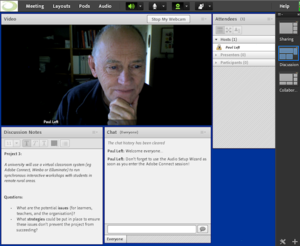Online learning communities
| Learning and Teaching in Practice | |
|---|---|
| Module 8: Personalised learning and diagnostic assessments | |
| Communities of Practice | Introduction | Online learning communities | Learning communities in practice | Summary |
In the previous section we looked at how a community of practice provides a learning environment for building and improving the shared practice of its learners. We also saw in the case studies how educators can participate in such communities either in relation to their subject (Emilia) or to their role as an educator (Brett).
Learning communities
Wenger's concept of the community of practice has been widely influential in education as well as in the corporate world.
Seeing the learning benefits of communities of practice, educators have incorporated aspects of this approach into courses, including:
- Sharing of information and resources through collaboration and interaction.
- Sharing personal and professional experiences and expertise.
- Learning through interaction with peers.
- Building knowledge and expertise through mentoring, including informal and peer mentoring.
However, educational courses tend to be of limited duration and scope: they usually involve a specific cohort of enrolled learners who come together for a single semester, say. There is clearly a tension here with the full-blown community of practice model which is sustained over the long term and where the membership gradually changes as members enter and leave the community.
Since it is not straight-forward to simply transplant the community of practice approach into education, it can be helpful and accurate to use the term learning community when such approaches are incorporated into courses.
To gain the benefits of the full community of practice approach, educators may also attempt to build a broader, more sustainable community through:
- Actively connecting learners to existing external communities.
- Creating opportunities for interaction and collaboration across multiple courses within a programme or across multiple programmes.
|
In the topic on Designing blended learning, we saw how Emilia planned to incorporate existing open educational resources (OER) into a sociology in health course within the Bachelor of Nursing. She now decides it would be useful for learners to connect with a broader community of people studying sociology in multiple health disciplines, so she recommends that teachers develop learning activities based around interaction within the Sociology online community. |
|
Brett's department has a growing number of learners who are working full time and have little time to come on campus and interact with teachers and their peers. In addition, some learners are enrolled in only one small paper, so have little contact with others. There is a growing tendency for learners to be isolated within specific courses and to have little sense of the 'big picture' of the programme as a whole. Currently, each course has a Moodle presence. Brett recommends setting up a 'meta-course' in Moodle for the programme as a whole which will be available automatically to anyone enrolled in a specific course. The meta-course will provide a common online 'space' for all learners in the programme to share expertise and knowledge. |
Online tools
The communities of practice originally studied by Wenger and others were predominantly based on face-to-face interaction between members, often in informal settings such as in lunch-rooms rather than in formal meetings.
While this is often still the case for communities of practice within a single workplace, broader communities (such as the ones that Emilia and Brett belong to) tend to rely on online interaction. We have seen in the examples of Emilia and Brett above how they have incorporated the use of online tools to help build and maintain learning communities.
Siemens identifies the sorts of online tools that enable interaction and collaboration within an online community:
- A learning community is comprised of different spaces. Each space addresses a type of learning, as well as a stage in the learning process. The major spaces needed in an community are for:
- Gurus and Beginners to connect (master/apprentice)
- self-expression (blog, journal)
- debate and dialogue (listserv, discussion forum, open meetings).
Also these spaces enable the community to:
- search archived knowledge (portal, website)
- learn in a structured manner (courses, tutorials).
- Source: Learning Ecology, Communities, and Networks
But successful communities often use a richer set of tools within a single system such as a learning management system which provides both synchronous chat and asynchronous forums. A social networking tool such as Ning also provides a rich set of features and tools which may be useful for building an online learning community, including a strong sense of 'personal presence' for members.
Another approach is to build a network of interlinked tools: e.g., separate individual blogs and/or wikis linked through tagging, RSS, blogrolls, comments and pingbacks.
Discussion forums
Benefits of Using Discussion Boards in Your Classes
Virtual classrooms
The image on the right shows Adobe Connect, a synchronous learning platform which provides text, video and audio communication as well as a shared 'whiteboard' and other tools for collaboration.
Wikis
10 Best Practices for using wikis in education
Blogs
Virtual worlds
Social networking tools
Think social networking for education
Using Ning as a School Social Network


